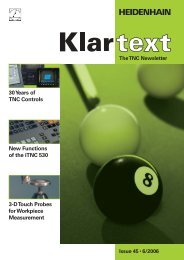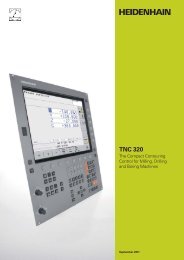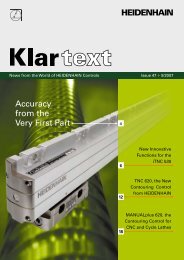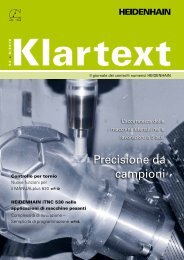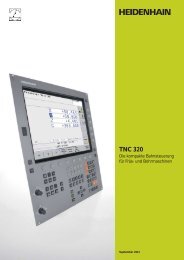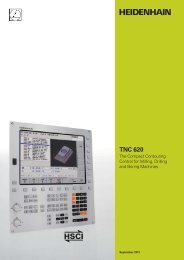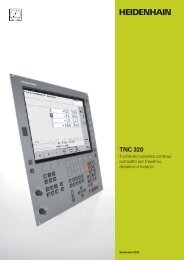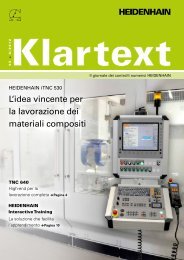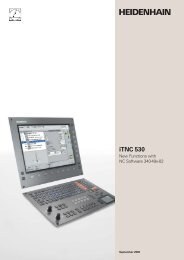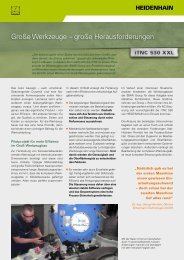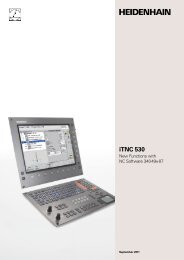iTNC 530 - TNC 640 - DR. JOHANNES HEIDENHAIN GmbH
iTNC 530 - TNC 640 - DR. JOHANNES HEIDENHAIN GmbH
iTNC 530 - TNC 640 - DR. JOHANNES HEIDENHAIN GmbH
Create successful ePaper yourself
Turn your PDF publications into a flip-book with our unique Google optimized e-Paper software.
Minimize Setup Times<br />
– The <strong>i<strong>TNC</strong></strong> <strong>530</strong> Makes Setup Easy<br />
Before you can begin machining, you must<br />
fi rst clamp the tool and set up the machine,<br />
fi nd the position and orientation of the<br />
workpiece on the machine, and set the<br />
workpiece reference point. This is a timeconsuming<br />
but indispensable procedure.<br />
After all, any error directly reduces the<br />
machining accuracy. Particularly in small<br />
and medium-sized production runs, as well<br />
as for very large workpieces, setup times<br />
become quite a signifi cant factor.<br />
The <strong>i<strong>TNC</strong></strong> <strong>530</strong> features application-oriented,<br />
real-world setup functions. They support<br />
the user, help to reduce non-productive<br />
time, and make overnight, unattended<br />
production possible. Together with the<br />
3-D touch probes, the <strong>i<strong>TNC</strong></strong> <strong>530</strong> offers<br />
numerous probing cycles for automatic<br />
alignment of the workpieces, presetting,<br />
and measurement of the workpiece and<br />
the tool.<br />
24<br />
Delicate manual traverse<br />
For setup, you can use the direction keys<br />
to move the machine axes manually or in<br />
incremental jog. A simpler and more<br />
reliable way, however, is to use the<br />
electronic handwheels from <strong>HEIDENHAIN</strong><br />
(see page 45). Particularly with the portable<br />
handwheels you are always close to the<br />
action, enjoy a close-up view of the setup<br />
process, and can control the infeed<br />
responsively and precisely.<br />
Workpiece alignment<br />
With the 3-D touch probes from<br />
<strong>HEIDENHAIN</strong> (see page 42) and the<br />
probing functions of the <strong>i<strong>TNC</strong></strong> <strong>530</strong>, you<br />
can forgo any tedious manual alignment<br />
of the workpiece:<br />
Clamp the workpiece in any position.<br />
The touch probe ascertains the<br />
workpiece misalignment by probing a<br />
surface, two holes, or two studs.<br />
The <strong>i<strong>TNC</strong></strong> <strong>530</strong> compensates the<br />
misalignment with a “basic rotation,”<br />
which means that in the NC program the<br />
part is rotated by the measured<br />
misalignment.<br />
Compensating workpiece misalignment<br />
Compensate misalignment by rotating the<br />
coordinate system or turning the table



